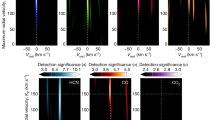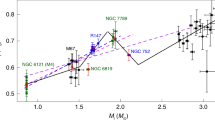Abstract
Stellar evolution theory predicts that the luminosity of the Sun has increased by ∼30% over the past 4,000 Myr. Yet geological and biological evidence indicates that the climate of the Earth between 3,000 and 4,000 Myr ago was as warm as, or warmer than, today. This apparent contradiction, the ‘faint Sun paradox’, has been resolved by invoking the greenhouse effect of radiatively active gases in the early Earth atmosphere. Sagan and Mullen1 first suggested that the concentration of ammonia in the early atmosphere was around 10–100 p.p.m., sufficiently high to counteract the reduced luminosity. However, because ammonia photodissociates readily and has a short atmospheric residence time2,3, such a concentration could be maintained only by a large continuous ammonia source. For this reason, carbon dioxide is now considered to have been the radiatively active gas4–7. Some atmospheric ammonia is, nevertheless, required to provide conditions conducive to the origin of life8. We now show that, if the early Earth's atmosphere contained high concentrations of CO2, as suggested above, then the chemical conditions required for life to begin can be maintained by very low ammonia partial pressures, rather similar to those observed today.
This is a preview of subscription content, access via your institution
Access options
Subscribe to this journal
Receive 51 print issues and online access
$199.00 per year
only $3.90 per issue
Buy this article
- Purchase on Springer Link
- Instant access to full article PDF
Prices may be subject to local taxes which are calculated during checkout
Similar content being viewed by others
References
Sagan, C. & Mullen, G. Science 177, 52 (1972).
Abelson, P. H. Proc. natn. Acad. Sci. U.S.A. 55, 1365 (1966).
Kuhn, W. R. & Atreya, S. K. Icarus 37, 207 (1979).
Owen, T. in Evolution of Planetary Atmospheres and Climatology of the Earth, 1–10 (CNES, Toulouse, 1978).
Henderson-Sellers, A. & Meadows, A. J. in Evolution of Planetary Atmospheres and Climatology of the Earth, 25–30 (CNES, Toulouse, 1978).
Owen, T., Cess, R. D. & Ramanathan, V. Nature 277, 640 (1979).
Henderson-Sellers, A., Benlow, A. & Meadows, A. J. Q. Jl R. astr. Soc. 21, 74 (1980).
Bada, J. L. & Miller, S. L. Science 159, 423 (1968).
Pinto, J. P., Gladstone, G. R. & Yung, Y. L. Science 210, 183 (1980).
Sillén, L. G. & Martell, A. E. Stability Constants of Metal-Ion Complexes (Chemical Society Special Publication No. 17, 1964).
Robie, R. A., Hemingway, B. S. & Fisher, J. R. Bull. geol. Surv. 1452 (1978).
Wright, J. M., Lindsay, W. T. Jr & Druga, T. R. U. S. Atomic Energy Commission R and D Rep. WAPD-TM-204 (1961).
Rubey, W. W. Bull. geol. Soc. Am. 62, 1111 (1951).
Söderlund, R. & Svensson, B. H. in Nitrogen, Phosphorus and Sulphur: Global Cycles (eds. Svensson, B. H. & Söderlund, R) 23–73 (SCOPE Rep. 7, Stockholm, 1976).
Georgii, H. W. & Gravenhorst, G. Pure appl. Geophys. 115, 503 (1977).
Harned, H. S. & Davies, R. Jr J. Am. chem. Soc. 65, 2030 (1943).
Schidlowski, N., Appel, P. W. V., Eichmann, R. & Junge, C. E. Geochim. cosmochim. Acta 43, 189 (1979).
Bridgwater, D. et al. Nature 289, 51 (1981).
Nagy, B., Engel, M. H., Zumberge, J. E., Ogino, H. & Chang, S. Y. Nature 289, 53 (1981).
Hart, M. H. Icarus 33, 23 (1978).
Levine, J. S., Augustsson, T. R. & Hoell, J. M. Geophys. Res. Lett. 7, 317 (1980).
Lodge, J. P., Machado, P. A., Pate, J. B., Sheesly, D. C., Wartburg, A. F. Tellus 26, 250 (1974).
Henderson-Sellers, A. & Schwartz, A. W. Nature 287, 526 (1980).
Sagan, C. Nature 269, 224 (1977).
Author information
Authors and Affiliations
Rights and permissions
About this article
Cite this article
Wigley, T., Brimblecombe, P. Carbon dioxide, ammonia and the origin of life. Nature 291, 213–215 (1981). https://doi.org/10.1038/291213a0
Received:
Accepted:
Issue Date:
DOI: https://doi.org/10.1038/291213a0
This article is cited by
-
Physical non-equilibria for prebiotic nucleic acid chemistry
Nature Reviews Physics (2023)
-
Habitability of the early earth: Clues from the physiology of nitrogen fixation and photosynthesis
Origins of life and evolution of the biosphere (1985)
-
Life span of the biosphere
Nature (1982)
-
Climate and paleoclimate: What we can learn about solar luminosity variations
Solar Physics (1981)
Comments
By submitting a comment you agree to abide by our Terms and Community Guidelines. If you find something abusive or that does not comply with our terms or guidelines please flag it as inappropriate.



